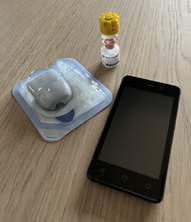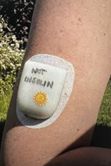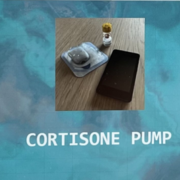The road to hydrocortisone pump treatment

A story on the experiences with a hydrocortisone pump by Laila Erntnes, director at the Norwegian Morbus Addison association.
I have used my hydrocortisone pump for about five years, and cannot imagine a life without it. In fact, the thought of having to do without it makes me quite anxious as I don’t want to go back to the state I was in, before I started using it. Well over a year ago, the rules for the use of Solu-Cortef were changed in a number of countries, including in Norway. From having been able to use the same solution for three days, it was now only usable for one day! This was determined through a dialogue between the pharmaceutical industry and the health authorities in the various countries. Therefore, it may differ from country to country. The risk of bacterial growth is present and therefore care is taken not to have the diluted solution left out too long.
This change in regulations made the doctors in Norway conclude that it was too strenuous and financially irresponsible to use a pump. For those of us using a pump, this meant that it had to be changed and filled with new hydrocortisone solution every day. A very important information in this regard is that the medicine Solu-Cortef had not changed (there were rumors that some substances had been withdrawn), but the reason is that the health authorities started using new criteria. These criteria are different depending on which country you live in. If you live in the USA, Solu-Cortef can still be used within three days, if you live in Norway or Sweden, Solu-Cortef it must be used in one day. If you are unlucky enough to live in Denmark, Solu-Cortef must be used within 6 hours. And remember, it is exactly the same medicine.
When this news first hit me, I was afraid I would have to stop using the pump. Fortunately, those of us who had already started treatment with a pump were allowed to continue and to change the solution every three days at our own risk. It was no longer something that the doctors could recommend, as they would be going against the Norwegian health authorities. As I have had such a good experience with the pump, I happily continue with the pump and still change it every three days. I don’t notice that my daily health is worse on day three, so I don’t see the need to switch it after only one day.
I think it is very unfortunate that these new regulations result in fewer people being allowed to try this form of treatment. It was already difficult enough to get doctors to agree to let us try it before. Now, it is almost impossible for new people to have access to hydrocortisone pump treatment.
For someone like me, who has experienced such positive effects with the pump, I find this tragic. However, pump treatment is not for everyone. If you think your day goes well with tablets, then it is a good treatment option for you. Pump treatment is for those who experience unstable yo-yoing levels of cortisol during the day with tablets. Or for those who experience severe symptoms where it might be worth trying another treatment to see whether it can improve quality of life. I don’t think we should just accept that life is difficult, without first getting to try the other possibilities that exist.
When I started using hydrocortisone after having surgery to remove my adrenal glands, I started with tablets three times a day. This is the most common treatment. I felt that I functioned very poorly in everyday life. Quite quickly after taking a tablet, I experienced overdose symptoms such as restlessness, hot flashes and rapid breathing. I could sit completely calmly on the sofa and suddenly turn completely red in the face and feel hot. I also experienced this when I had Cushing disease. Despite the restlessness, I had to lie down for about an hour, due to a strong sense of illness. Then I had a couple of hours where I felt okay, before I experienced the symptoms of low cortisol, with feelings of nausea and weakness. Then it was time to take another tablet – only to get overdose symptoms again. It was a real roller coaster during the day. Because of this, I got to try Plenadren (slow release). It was a big disappointment. I was very tired all day. Everything became a struggle, and I could not function properly as a mother, which is of course very important when you have three children. Adrenal insufficiency patients must try Planadren for at least three months before they can conclude whether it works or not. Some have succeeded in persevering for six months before the Plenadren has had a positive effect. I gave up after three months.
At this point I went to a doctor in my own town that had actually retired. He was a good listener, understanding and solution-oriented. In addition, he was respected in the hospital and was not afraid of reprisals from the hospital management, so he started me on hydrocortisone pump treatment as his first patient. Pump treatment is considered the most expensive treatment. I had to attend a training meeting with a representative of the pump manufacturer. The training lasted two hours and there was a lot to remember. I’m glad I had my husband with me, who is a little more patient in understanding new technology than I am.
It is common to set up four or five dosage times of hydrocortisone throughout the day when using the pump. The pump starts by increasing the influx of hydrocortisone at four o’clock in the morning. Then there is a higher dose that starts at eight o’clock. A slightly lower dose is given again from twelve o’clock (noon), and then finally at six o’clock in the evening. This dose lasts until four in the morning. Note that there is never a break in the supply of hydrocortisone in the body. The supply of hydrocortisone is around the clock, but in different amounts depending on the time of day. For those of you familiar with insulin therapy, which the pumps are usually used for, this is what is called the basal dose. Those with diabetes administer an extra dose of insulin at meal times, in addition to the basal insulin dose. This extra dose, which is given quickly, is called a bolus. Those of us using hydrocortisone can also administer a bolus when we require an extra dose, for example, during stressful events or intense effort.
Getting a pump was a salvation for me, although not right away … The doses that the endocrinologist had suggested to use in the pump had to be slightly adjusted. It took a few months of trial and error to find the right dose. It is common that you need less hydrocortisone when using a pump, but here you can only compare yourself to yourself. I seem to require more than what I have heard other pump users need. It is probably due to my original diagnosis of Cushing disease, caused by a pituitary tumor. I went many years undiagnosed where my body produced too much cortisol. This has probably caused my body to need slightly higher amounts of hydrocortisone to function. My daily dose is 41.6 ml of Solu-Cortef.
There are several manufacturers of pumps, all of which are used for insulin pump therapy. Today I use OmniPod which is the one without a tube. I started with Medtronic which has a tube. It wasn’t a big problem. The advantages outweighed the disadvantages of the tube, but now that there is a tubeless option, I think it is best. I can bathe, shower and do whatever I want without having to take the pod off. It also comes with a remote control.

At this time, I have stable days and experience a great degree of mastery over my everyday life compared to the first years prior to using the pump. I still have some quiet days, where I need good breaks, but it is now easier to do more of what I have to do and more of what I want to do.
As you can see, I perhaps struggled more than many with tablets that provided unsatisfactory results, and it is for this patient group that hydrocortione pump treatment may be relevant. I keep hearing stories from patients with adrenal insufficiency who have tough days and I wish more people were allowed to try it. We must not only survive, but also have mastership over our everyday lives and participate in family life and perhaps even work.
My big wish is that hydrocortisone pump treatment becomes more common in the treatment of adrenal insufficiency. I believe that this will lead to many more patents having an increased quality of life.

Laila Erntnes,
Norwegian Morbus Addison association



